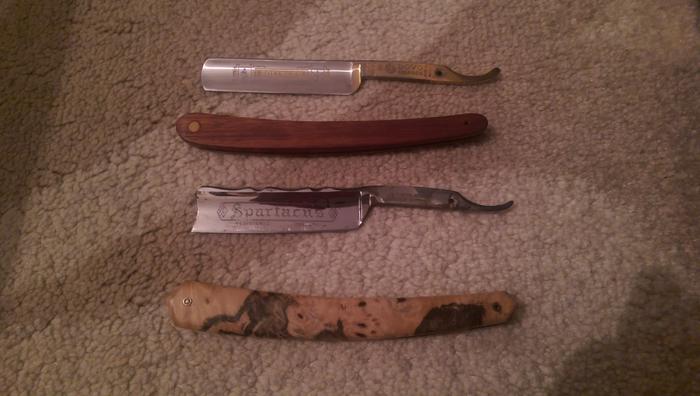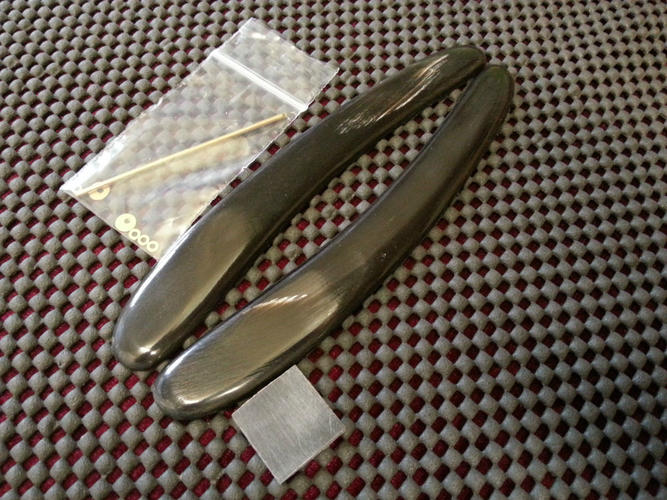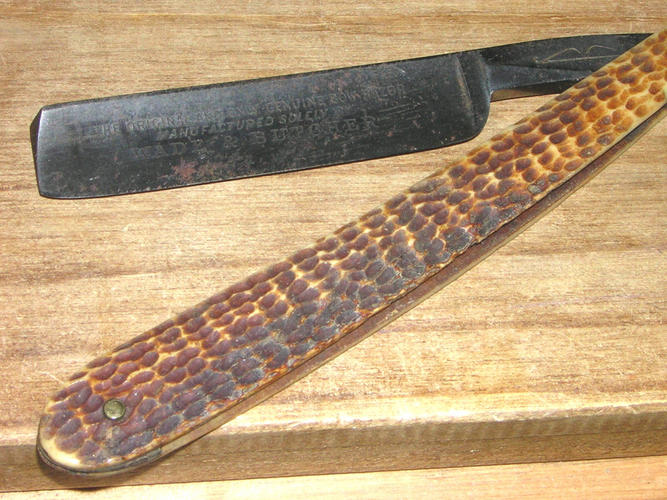Results 11 to 20 of 57
Thread: Tightening pins
-
09-02-2015, 12:44 PM #11

Looks good to me. The "standard" pin rod diameter is usually given as 1/16", so 1.5mm is pretty much bang on. You can get the individual bits cheaper if you look around, but it would be nice to get all in one. Another good thing is that it looks like it includes internal washers as well as the external ones, so you can do as Jamie suggested and add in some internal washers while you're at it.
Thinking back to my first re-pinning efforts, it might also be good to have plenty of extra material for when things go pear shaped.
And remember - LIGHT taps are all you need. Your razor-bashing days are over, right?
It was in original condition, faded red, well-worn, but nice.
This was and still is my favorite combination; beautiful, original, and worn.
-Neil Young
-
The Following User Says Thank You to Cangooner For This Useful Post:
JOB15 (09-02-2015)
-
09-02-2015, 12:53 PM #12

Not necessarily. Closing the blade will force it into the scales just because the tang is the widest part and will ensure the rest of the blade closes. However, you could get to a stage where the scale alignment is so far out that the edge catches the scales - that can obviously damage the edge.
If you are inexperienced with fitting scales and re-pinning, this might not be the best place to start - the TI scales are burl which can be easily broken. You might want to see if there is anyone who will do it for you.My service is good, fast and cheap. Select any two and discount the third.
-
The Following User Says Thank You to UKRob For This Useful Post:
JOB15 (09-02-2015)
-
09-02-2015, 01:00 PM #13Senior Member



- Join Date
- Mar 2012
- Location
- Thunder Bay, Ontario, Canada
- Posts
- 17,326
Thanked: 3228
Those scales are expensive and might not be the ideal candidates to try your first pin removal on. Just thinking back on my attempts at pin removal. It might be worth while to send it to have it done.
Yes bashing hard likely bent the pin and because TI uses those nail type pins I don't think bashing the hail head side would do any good anyway.
Cheapest alternative would be to leave it alone and caution your brother to be careful closing the blade as it does now close without hitting the scales just a little off center.
BobLife is a terminal illness in the end
-
The Following User Says Thank You to BobH For This Useful Post:
JOB15 (09-02-2015)
-
09-02-2015, 01:11 PM #14

Jobs a gooden.
I copied a YouTube video and used my Dremel cutter .
Now its out of the scales I can clean up the areas I couldn't get to before.
My brother has no respect for his razors and lets them get rusty. Luckily I enjoy fixing and cleaning things up.
Edit: For future reference I think using the dremel cutter to mark an X and then drill out the pin is the best option.Last edited by JOB15; 09-02-2015 at 01:26 PM.
-
09-02-2015, 01:14 PM #15

I've removed a pins from 2 razors in the past but I didn't like my technique . Using flat cutters and brute force damaged the scales . I was replacing those scales so it didn't matter if I damaged them.
Also previously I used the bolt and nut type pins which are a bit crap so ill swap them out now.
-
09-02-2015, 01:33 PM #16

I have these to do now and a restoration in a while which includes making a wedge.
I take it the wedge can be flat or does it have to be wedge shaped?

-
09-02-2015, 02:00 PM #17Senior Member



- Join Date
- Mar 2012
- Location
- Thunder Bay, Ontario, Canada
- Posts
- 17,326
Thanked: 3228
-
The Following User Says Thank You to BobH For This Useful Post:
JOB15 (09-02-2015)
-
09-02-2015, 02:03 PM #18

The wedge-shape serves a function in that it bows the scales out a bit and places them under a bit of tension, all of which helps them do their job. If you have thin, flexible scale material that is not bowed out, it may instead bow inwards. If that happens, then you'll have problems keeping the edge from contacting the scales when closing, etc. Also it just looks bad.

That having been said, and depending on the scale material, you can opt for a spacer instead. Spacer = non-wedge-shaped 'wedge'. A spacer can be handy if you are dealing with stiffer scale material that won't bend or otherwise react well to the tension imparted by a wedge. I have done this with wooden scales in the past, but largely because I made the things too thick to be readily bendy. In hindsight, I wish I had thinned them out more and used a proper wedge, but they work OK.
It was in original condition, faded red, well-worn, but nice.
This was and still is my favorite combination; beautiful, original, and worn.
-Neil Young
-
The Following User Says Thank You to Cangooner For This Useful Post:
JOB15 (09-02-2015)
-
09-02-2015, 02:03 PM #19Senior Member



- Join Date
- Mar 2012
- Location
- Thunder Bay, Ontario, Canada
- Posts
- 17,326
Thanked: 3228 Life is a terminal illness in the end
Life is a terminal illness in the end
-
The Following User Says Thank You to BobH For This Useful Post:
JOB15 (09-02-2015)
-
09-02-2015, 02:17 PM #20

Ok so there is more to it than just a gap filler..
I will be using these cheap ebay horn scales on this W&B blade.
If I had the tools I would like to fashion the scales from wood.




 39Likes
39Likes LinkBack URL
LinkBack URL About LinkBacks
About LinkBacks












 Reply With Quote
Reply With Quote